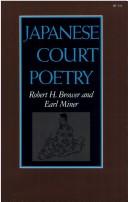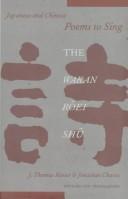| Listing 1 - 3 of 3 |
Sort by
|
Book
ISBN: 2251490035 9782251490038 Year: 1996 Volume: 4 Publisher: Paris : Les Belles Lettres,
Abstract | Keywords | Export | Availability | Bookmark
 Loading...
Loading...Choose an application
- Reference Manager
- EndNote
- RefWorks (Direct export to RefWorks)
Japanese poetry --- Poésie japonaise --- Literary collections --- Anthologies --- Tanka (poésie japonaise) --- Haïku --- Renga --- Haïku. --- Renga. --- Tanka (Poésie japonaise) --- Japanese poetry. --- Poesie japonaise --- poésie japonaise --- Translations into French. --- Histoire et critique. --- Anthologies. --- Traductions françaises. --- Tanka (Poésie japonaise). --- Poésie japonaise

ISBN: 0804705364 9780804705363 0804715246 9780804715249 Year: 1975 Publisher: Stanford, Calif. : Stanford University Press,
Abstract | Keywords | Export | Availability | Bookmark
 Loading...
Loading...Choose an application
- Reference Manager
- EndNote
- RefWorks (Direct export to RefWorks)
Japanese poetry --- Poésie japonaise --- History and criticism. --- Histoire et critique. --- Tanka (Poésie japonaise)

ISBN: 0231107021 023110703X 9780231107020 9780231107037 Year: 1997 Publisher: New York : Columbia University Press,
Abstract | Keywords | Export | Availability | Bookmark
 Loading...
Loading...Choose an application
- Reference Manager
- EndNote
- RefWorks (Direct export to RefWorks)
This first English translation of the Wakan roei shu, includes two introductory essays, insightful commentaries on each passage, and three expositions, which discuss the collection's influence on Japanese literary history, music, and calligraphy. For centuries these short, evocative poems were memorized and cherished by Japanese courtiers who sang them at court, into lovers' ears, or at moments when spoken words failed to express their feelings. Most of the Chinese selections in this book are excerpts taken from much longer poems, with one or two verses of the original chosen to harmonize with Japanese aesthetic tastes. Now English-speaking readers can enjoy the Wakan roei shu, long treasured by Japanese readers for its revelatory beauty. The collection - arranged in accordance with the four seasons and covering more than forty topics, from celestial bodies to ministers of state - includes poems by some of the most beloved Chinese and Japanese masters, including Po Chu-i (772-846) and Sugawara no Michizane (845-903). Like haiku, the poems in the Wakan roei shu are brief and reflective, with many adhering to the classical Japanese poetic form of thirty-one syllables. Until the Meiji Restoration (1868-1912), calligraphers, poets, and artists looked to the Wakan roei shu for inspiration, incorporating its text into many of Japan's most celebrated masterpieces, from the no play Takasago to the Tale of Genji and the calligraphy of Fujiwara no Yukinari, whose eleventh-century calligraphic interpretations of the collection were treasured by Japanese for centuries.
Anthologie. --- Chinese poetry --- Chinese poetry. --- Chinesisch. --- Japanese poetry --- Japanese poetry. --- Japanisch. --- Lied. --- Lyrik. --- Poésie chinoise --- Poésie japonaise --- Tanka (poésie japonaise) --- Waka --- Waka. --- Traductions anglaises. --- To 1185.
| Listing 1 - 3 of 3 |
Sort by
|

 Search
Search Feedback
Feedback About UniCat
About UniCat  Help
Help News
News